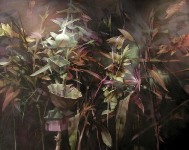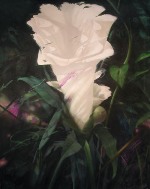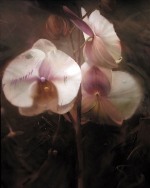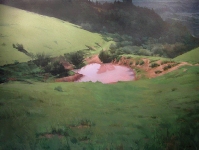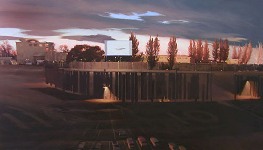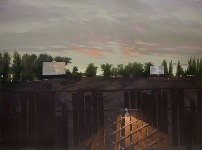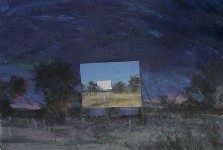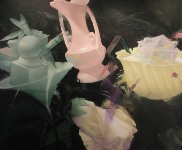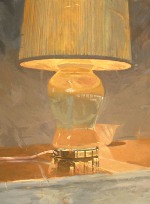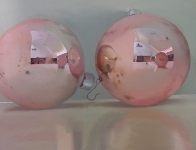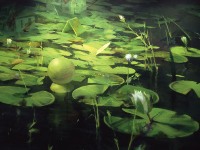Tony Smith’s paintings are works in motion. They are thought-provoking in countenance and effect, abundant in visual and psychological intrigue. Inventive, ironic, and often humorous, they combine disparate objects, unexpected color and scale, varied painting techniques, multiple light sources, and highly illusionistic passages. Smith’s subjects take an adventurous course, the two-dimensional surfaces imbued with magic, possibility, and surprise.
[Click on pictures to enlarge.]
Still life and landscape motifs fill his canvases. Among many identifiable objects, curious shapes, and geometric forms, are found hillsides, rocks, sticks, and dirt. Such favored elements reflect Smith’s experience of the West: the flat desert spaces, the texture of the mountains, the strong light, the clarity of sight that carries for miles. These are part of his visual personality and instill in his works an association with basic aspects of everyday life and with the captivating presence of nature.
Within this lexicon of imagery, Smith’s paintings are his imagination. Whether the catalyst is an object or experience, a dialogue between two colors, or a fascination with shape and volume; whether the techniques used are airbrush, sponge, hands, or paintbrush, his works evolve from a self-defined logic. Only recently has Smith ventured to paint from life. "My training," he says, "wasn’t to paint a landscape; I wanted to invent it in my mind and then paint it, or invent it as I paint it."
Smith’s dream world is informed and interpreted by light. He plumbs its properties in unanticipated ways often combining natural and artificial illumination, drawn from exposed and concealed sources, which reside both within and outside pictorial space. A landscape silhouetted against a sunset sky, for example, is doubly illuminated by the spotlight of a studio clip-on lamp. This lamp, in turn, is juxtaposed with the apparition of a table lamp, looming in the branches of a tree, from which a ghostly light emanates. Smith’s light—a warm glow or cool iridescence—is personal: day and nocturnal light, lamp light, match light, and television light—light that is intimate, nostalgic, mysterious, and revelatory. Always it is forged from Smith’s own logic which, to him, brings forth "memory and associations encrusted with reflections and mood."
As light carries its own rationale, so too are color and form believable in the contexts that Smith creates for them. Often a two-color dialogue is enough to inspire a painting. A stick turns vivid red in eerie green illumination: red-brown and blue-green textural fields intersect. Smith’s color/form relationships evolve on canvas, challenging and entertaining the artist and viewer in their making. He is fascinated with geometry: triangles paired with circles, circles within triangles, triangles within squares. His juxtapositions of color and form create suggestive metaphors (a gray-green lava rock centered on a red sandstone ground recalls the design of the Japanese flag) and engaging opposites (a conical hole filled with water is paired with the cone shape itself, upturned, its peak tinting the blue-green of the water-filled impression). There is a delightful uneasiness to these works, an unsettling energy that draws us to them, teasing our notions of the function and demeanor of things, while inspiring a connection with our imaginations.
The magnetism of Smith’s paintings is increased by this convincing illusionism. Illusionistic volumes range from the thinness of paper to sizeable cubes and spheres. Compositions may be simple; or they are a cacophony of elements, their frenetic complexity amassed in multiple layers of humor and irony. A canvas often appears to be peeled back in places, window-like, to reveal deep landscape views, or playfully, to expose other impenetrable surfaces. Scale is manipulated, gravity is defied, light sources multiply, and points of view abound. Illusion, to Smith, is a way of putting things together so we believe they are there. It creates a reality that is "stronger, like perfume," he says, "certainly stronger than we see with our regular senses, which are so habitualized." Yet, however remarkable the illusion, Smith reasserts that his image-making is inseparable from the painting process. He may juxtapose painterly and illusionistic information; portray a brushstroke hovering over the canvas as an object to be reckoned with; or incorporate a light source that gives objects volume while simultaneously inducing a glare that seems to reflect off a flat surface. We are consistently reminded that the artist’s wellspring of ideas is played out on a two-dimensional plane.
Illusionism, to Smith, along with light and color, serves the imagination, not in terms of fool-the-eye deception, but with the serious intent of creating magical moments or eras. "What is important to me is magic," he says, "literal magic, a sense that the world is changeable, surprising, that it’s more than you think." The intriguing imagery that Smith conjures, often depicted from an exploratory bird’s-eye view, is in part influenced by his childhood memories of Yellowstone National Park and other fascinating sites. "The bubbling mud pots are doing this humorous thing and then you go to something else that’s grand," he recalls. "You are looking under the underworld, full of things you don’t really know are there. And when you get a glimpse of it, you are astonished." This just-around-the-corner dynamic is seen in such visions as a camera, still caked in the dirt and mire of excavation, that has as its lens the Morning Glory Pool of Yellowstone; or a boat, symbolic of searching and journey, filled with water and beached on salt-like oars. "Things emerging, something amazing, that potential," Smith says, is the source of invention that drive his work.


